Noble Metal Nanostructured Materials for Chemical and Biosensing Systems
Abstract
1. Introduction
2. Synthesis of Noble Metal Nanomaterials with Different Morphologies
2.1. Nanoparticles (NPs)
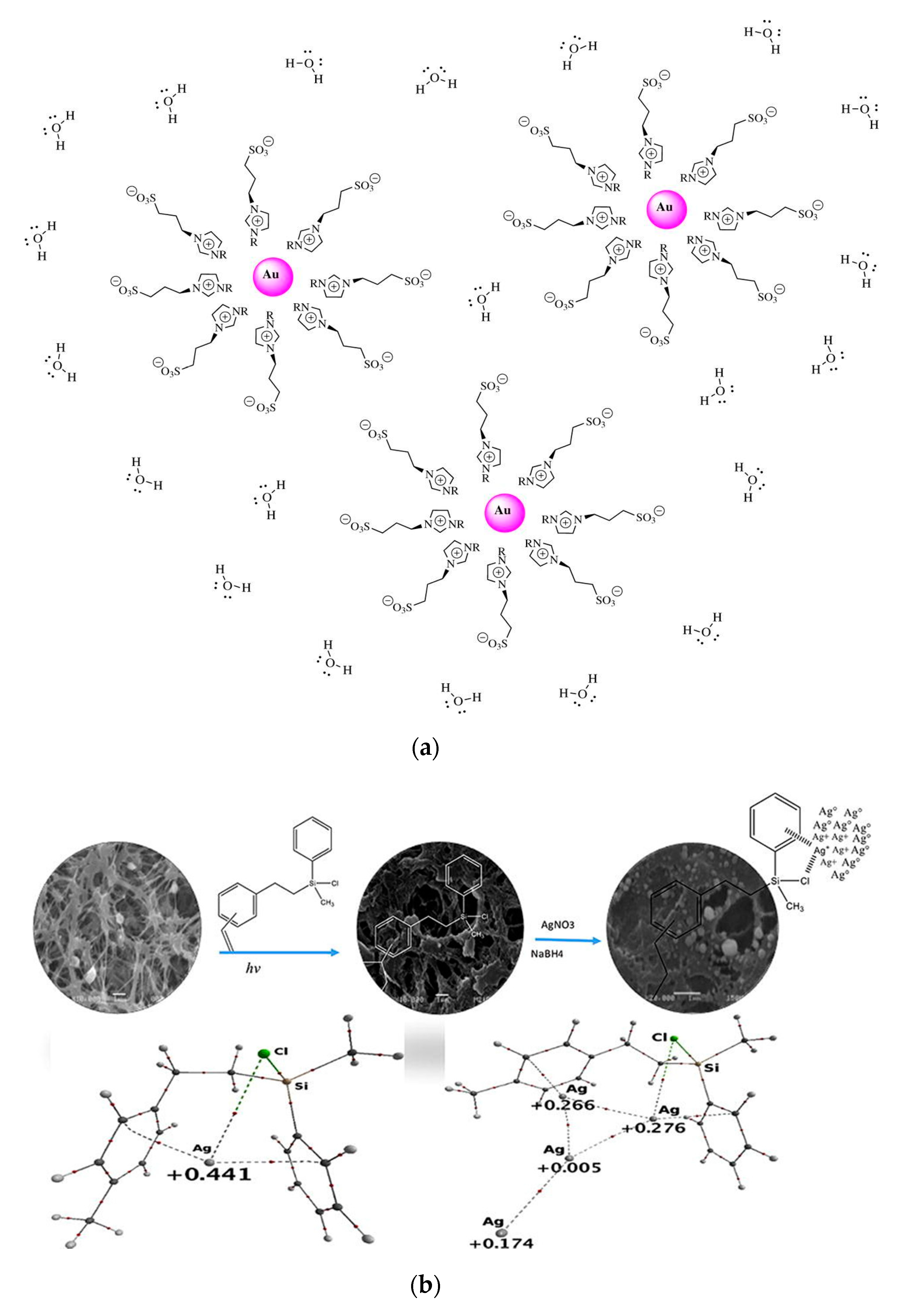
2.2. Nanorods (NRs)
2.3. Nanocage
2.4. Nanoclusters (NCs)
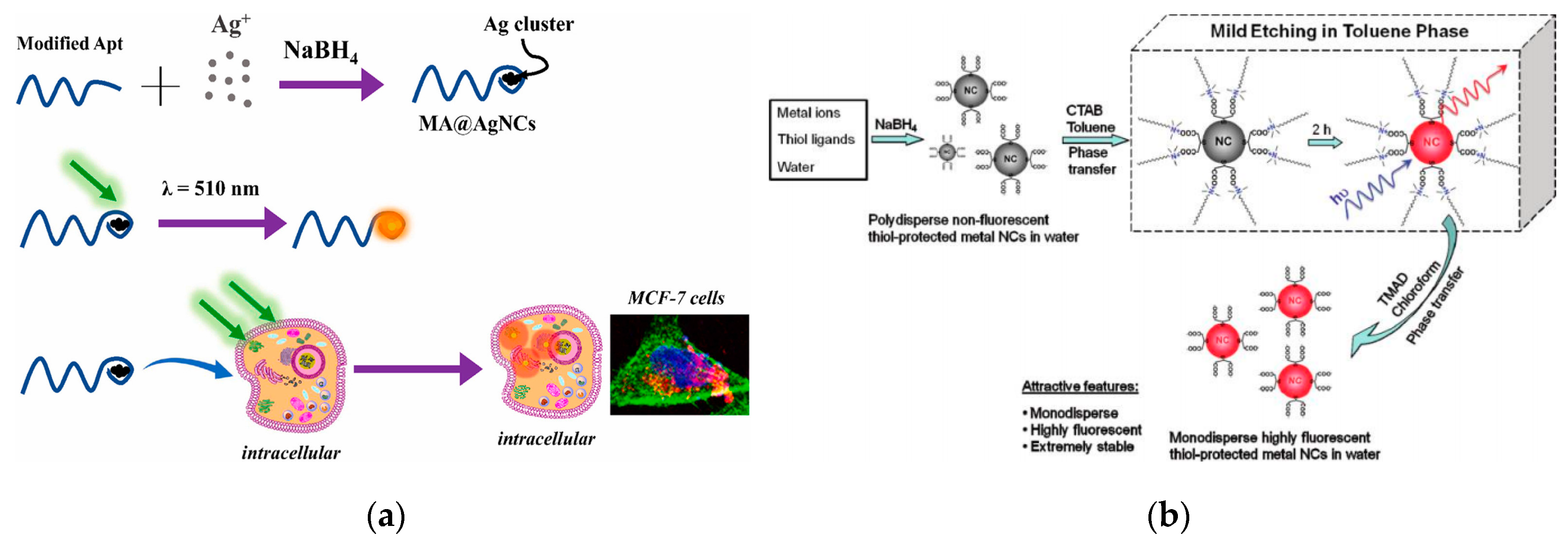
3. Application of Noble Metal Nanomaterials in the Field of Sensing
3.1. Optical Sensor
3.1.1. Fluorescence Sensing
3.1.2. UV-Visible Absorption Spectroscopy
3.1.3. Two-Photon Fluorescence Spectrometry
3.2. Electrochemical Sensor
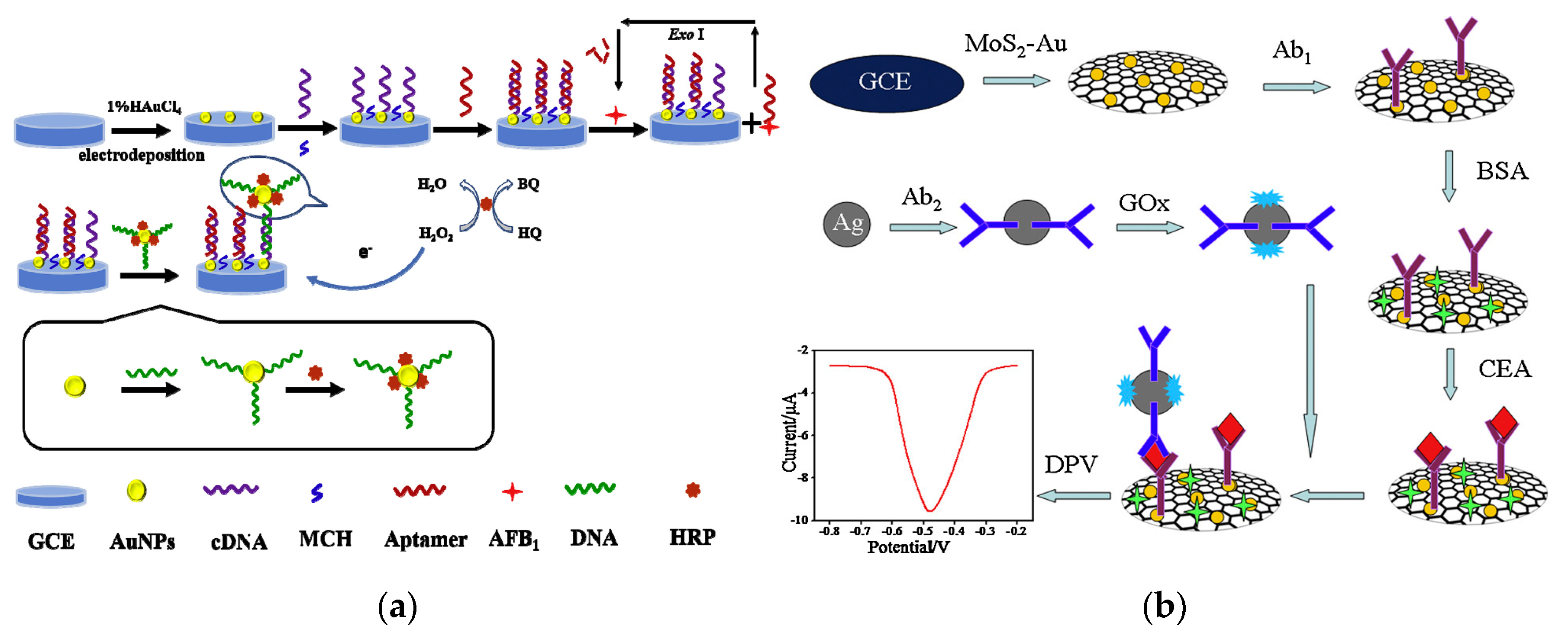
3.3. Other Kind of Sensors
4. Future Applications
Author Contributions
Funding
Conflicts of Interest
References
- Takagi, H.; Ogawa, H.; Yamazaki, Y. Quantum size effects on photoluminescence in ultrafine Si particles. Appl. Phys. Lett. 1990, 56, 2379–2380. [Google Scholar] [CrossRef]
- Tan, C.L.; Cao, X.H.; Wu, X.J. Recent advances in ultrathin two-dimensional nanomaterials. Chem. Rev. 2017, 117, 6225–6331. [Google Scholar] [CrossRef] [PubMed]
- Pan, M.F.; Yin, Z.J.; Liu, K.X.; Du, X.L.; Liu, H.L.; Wang, S. Carbon-based nanomaterials in sensors for food safety. Nanomaterials 2019, 9, 1330. [Google Scholar] [CrossRef] [PubMed]
- Oun, A.A.; Shankar, S.; Rhim, J.W. Multifunctional nanocellulose/metal and metal oxide nanoparticle hybrid nanomaterials. Crit. Rev. Food Sci. 2020, 60, 435–460. [Google Scholar] [CrossRef]
- Smith, B.R.; Gambhir, S.S. Nanomaterials for in vivo imaging. Chem. Rev. 2017, 117, 901–986. [Google Scholar] [CrossRef]
- Guan, B.Y.; Yu, X.Y.; Wu, H.B. Complex nanostructures from materials based on metal-organic frameworks for electrochemical energy storage and conversion. Adv. Mater. 2017, 29, 1703614. [Google Scholar] [CrossRef]
- McNamara, K.; Tofail, S.A.M. Nanoparticles in biomedical applications. Adv. Phys. X 2017, 2, 54–88. [Google Scholar] [CrossRef]
- Yang, X.; Yang, M.X.; Pang, B.; Vara, M.; Xia, Y. Gold nanomaterials at work in biomedicine. Chem. Rev. 2015, 115, 10410–10488. [Google Scholar] [CrossRef]
- Yang, C.; Denno, M.E.; Pyakurel, P.; Venton, B.J. Recent trends in carbon nanomaterial-based electrochemical sensors for biomolecules: A review. Anal. Chim. Acta 2015, 887, 17–37. [Google Scholar] [CrossRef]
- Liu, H.; Feng, J.T.; Jie, W.Q. A review of noble metal (Pd, Ag, Pt, Au)-zinc oxide nanocomposites: Synthesis, structures and applications. J. Mater. Sci. Mater. Electron. 2017, 28, 16585–16597. [Google Scholar] [CrossRef]
- Neyts, E.C.; Ostrikov, K.; Sunkara, M.K.; Boqaerts, A. correction: Plasma catalysis: Synergistic effects at the nanoscale. Chem. Rev. 2016, 116, 767. [Google Scholar] [CrossRef] [PubMed]
- Kim, H.; Mondal, S.; Jiang, B.; Manivasagan, P.; Moorthy, M.S.; Oh, J.; Manivasagan, P. Biomimetic synthesis of metal-hydroxyapatite (Au-HAp, Ag-HAp, Au-Ag-HAp): Structural analysis, spectroscopic characterization and biomedical application. Ceram. Int. 2018, 44, 20490–20500. [Google Scholar] [CrossRef]
- Zhao, S.F.; Li, J.H.; Cao, D.X.; Zhang, G.P.; Li, J.; Li, K.; Yang, Y.; Wang, W.; Jin, Y.F.; Sun, R.; et al. Recent advancements in flexible and stretchable electrodes for electromechanical sensors: Strategies, materials and features. ACS Appl. Mater. Interfaces 2017, 9, 12147–12164. [Google Scholar] [CrossRef] [PubMed]
- Rui, X.H.; Tan, H.T.; Yan, Q.Y. Nanostructured metal sulfides for energy storage. Nanoscale 2014, 6, 9889–9924. [Google Scholar] [CrossRef]
- Ma, L.; Hendrickson, K.E.; Wei, S.Y.; Archer, L.A. Nanomaterials: Science and applications in the lithium-sulfur battery. Nano Today 2015, 10, 315–338. [Google Scholar] [CrossRef]
- Gussone, J.; Reinhard, C.; Kasperovich, G.; Gherekhloo, H.; Merzouk, T.; Hausmann, J. In-situ investigation of microcrack formation and strains in Ag-Cu-based multi-metal matrix composites analysed by synchrotron radiation. Mater. Sci. Eng. A Struct. 2014, 612, 102–114. [Google Scholar] [CrossRef]
- Mayani, S.V.; Mayani, V.J.; Lee, J.Y.; Ko, S.H.; Lee, S.K.; Kim, S.W. Preparation of multi metal–carbon nanoreactors for adsorption and catalysis. Adsorption 2013, 19, 251–257. [Google Scholar] [CrossRef]
- Mitragotri, S.; Anderson, D.G.; Chen, X.; Chow, E.K.; Ho, D.; Kabanov, A.V.; Karp, J.M.; Kataoka, K.; Mirkin, C.A.; Petrosko, S.H.; et al. Accelerating the translation of nanomaterials in biomedicine. ACS Nano 2015, 9, 6644–6654. [Google Scholar] [CrossRef]
- Chimene, D.; Alge, D.L.; Gaharwa, A.K. Two-dimensional nanomaterials for biomedical applications: Emerging trends and future prospects. Adv. Mater. 2016, 27, 7261–7284. [Google Scholar] [CrossRef]
- Du, J.W.; Hu, X.; Zhang, G.W.; Wu, X.Q.; Gong, D.M. Colorimetric detection of cadmium in water using L-cysteine functionalized gold–silver nanoparticles. Anal. Lett. 2018, 51, 2906–2919. [Google Scholar] [CrossRef]
- Zheng, W.S.; Guo, Z.L.; Huang, Z.Z.; Zhuang, J.Q.; Yang, W.S. In-situ preparation of size-tunable gold nanoparticles in porous resorcinol–formaldehyde resin. Colloid Surf. A 2015, 484, 271–277. [Google Scholar] [CrossRef]
- Aldewachi, H.; Chalati, T.; Woodroofe, M.N.; Bricklebank, N.; Sharrack, B.; Gardiner, P. Gold nanoparticle-based colorimetric biosensors. Nanoscale 2017, 10, 18–33. [Google Scholar] [CrossRef] [PubMed]
- Spadavecchia, J.; Prete, P.; Lovergine, N.; Tapfer, L.; Rella, R. Au nanoparticles prepared by physical method on Si and sapphire substrates for biosensor applications. J. Phys. Chem. B 2018, 109, 17347–17349. [Google Scholar] [CrossRef] [PubMed]
- Wang, P.L.; Lin, Z.Y.; Su, X.S.; Tang, Z.Y. Application of Au based nanomaterials in analytical science. Nano Today 2017, 12, 64–97. [Google Scholar] [CrossRef]
- Her, S.; Jaffray, D.A.; Allen, C. Gold nanoparticles for applications in cancer radiotherapy: Mechanisms and recent advancements. Adv. Drug Deliv. Rev. 2017, 109, 84–101. [Google Scholar] [CrossRef]
- Chen, Y.P.; Xianyu, Y.; Jiang, X.Y. Surface modification of gold nanoparticles with small molecules for biochemical analysis. Acc. Chem. Res. 2017, 50, 310–319. [Google Scholar] [CrossRef]
- Su, L.J.; Xiong, Y.H.; Chen, Z.Y.; Duan, Z.H.; Luo, Y.H.; Zhu, D.J.; Ma, X.H. MoO3 nanosheet-assisted photochemical reduction synthesis of Au nanoparticles for surface-enhanced Raman scattering substrates. Sens. Actuators B Chem. 2018, 279, 320–326. [Google Scholar] [CrossRef]
- Yeh, Y.; Creran, B.; Rotello, V.M. Gold nanoparticles: Preparation, properties, and applications in bionanotechnology. Nanoscale 2012, 4, 1871–1880. [Google Scholar] [CrossRef]
- Ibrahim, N.A.; Eid, B.M.; Abdel-Aziz, M.S. Green synthesis of AuNPs for eco-friendly functionalization of cellulosic substrates. Appl. Surf. Sci. 2016, 389, 118–125. [Google Scholar] [CrossRef]
- Soliwoda, K.; Tomaszewska, E.; Tkacz-Szczesna, B.; Rosowski, M.; Celichowski, G.; Grobelny, J. The influence of the chain length and the functional group steric accessibility of thiols on the phase transfer efficiency of gold nanoparticles from water to toluene. Pol. J. Chem. Technol. 2014, 16, 86–91. [Google Scholar] [CrossRef]
- Ranoszek-Soliwoda, K.; Girleanu, M.; Tkacz-Szczesna, B.; Rosowski, M.; Celichowski, G.; Brinkmann, M.; Ersen, O.; Grobelny, J. Versatile phase transfer method for the efficient surface functionalization of gold nanoparticles: Towards controlled nanoparticle dispersion in a polymer matrix. J. Nanomater. 2016, 2016, 9058323. [Google Scholar] [CrossRef]
- Kauffman, D.R.; Alfonso, D.R.; Tafen, D.; Wang, C.J.; Zhou, Y.Y.; Yu, Y.; Lekse, J.W. Selective electrocatalytic reduction of CO2 into CO at small, thiol-capped Au/Cu nanoparticles. J. Phys. Chem. C 2018, 122, 27991–28000. [Google Scholar] [CrossRef]
- Gupta, M.; Mohapatra, S.S.; Dhara, S.; Pal, S.K. Supramolecular self-assembly of thiol functionalized pentaalkynylbenzene-decorated gold nanoparticles exhibiting room temperature discotic nematic liquid crystal. J. Mater. Chem. C 2018, 6, 2303–2310. [Google Scholar] [CrossRef]
- Tatarchuk, V.V.; Druzhinina, I.A.; Zaikovskii, V.I.; Maksimovskii, E.A.; Gromilov, S.A.; Gevko, P.N.; Petrova, N.I. Synthesis of gold nanoparticles and thin films with the use of micellar solution of Brij 30. Russ. J. Inorg. Chem. 2017, 62, 372–379. [Google Scholar] [CrossRef]
- Chernyshova, K.F.; Revina, A.A. The optical properties of metallic nanoparticles of Au, Ag and bimetallic nanoparticles of Au-Ag synthesized in reverse micelles. Sci. Intens. Technol. 2017, 18, 45–50. [Google Scholar]
- Dumas, C.; Meledandri, C.J. Insights into the partitioning behavior of secondary surfactants in a microemulsion-based synthesis of metal nanoparticles: A DLS and 2D NMR spectroscopic investigation. Langmuir 2015, 31, 7193–7203. [Google Scholar] [CrossRef]
- Monti, G.A.; Fernández, G.A.; Correa, N.M.; Falcone, R.D.; Moyano, F.; Silbestri, G.F. Gold nanoparticles stabilized with sulphonated imidazolium salts in water and reverse micelles. R. Soc. Open Sci. 2017, 4, 170481. [Google Scholar] [CrossRef]
- Ongaratto, R.; Conte, N.; D’Oca, C.R.M.; Brinkerhoff, R.C.; Ruas, C.P.; Gelesky, M.A.; D’Oca, M.G.M. In situ formation of AuNPs using fatty N-acylamino hydrazide organogelators as templates. New J. Chem. 2019, 43, 295–303. [Google Scholar] [CrossRef]
- Fan, Z.Y.; Chen, X.L.; Serrano, M.K.; Schmalz, H.; Rosenfeldts, S.; Forster, S.; Agarwal, S.; Greiner, A. Polymer cages as universal tools for the precise bottom-up synthesis of metal nanoparticles. Angew. Chem. Int. Ed. 2015, 54, 14539–14544. [Google Scholar] [CrossRef]
- Ana, L.M.J.; Pablo, C.M.; Fernando, C.G.; Rosa, M.G.E. Design of growing points for silver nanoparticles on polypropylene membranes. Chem. Phys. Lett. 2018, 693, 159–164. [Google Scholar]
- He, Y.P.; Sheng, Q.L.; Zheng, J.B. Double-template electrosynthesis of platinum nanomaterials for sensing application. Sens. Actuators B Chem. 2012, 166, 89–96. [Google Scholar] [CrossRef]
- Cao, J.; Sun, T.; Grattan, K.T.V. Gold nanorod-based localized surface plasmon resonance biosensors: A review. Sens. Actuators B Chem. 2014, 195, 332–351. [Google Scholar] [CrossRef]
- Zhang, L.M.; Xia, K.; Lu, Z.X.; Li, G.P.; Chen, J.; Deng, Y.; Li, S.; Zhou, F.M.; He, N.Y. Efficient and facile synthesis of gold nanorods with finely tunable plasmonic peaks from visible to near-IR range. Chem. Mater. 2014, 26, 1794–1798. [Google Scholar] [CrossRef]
- Zheng, Z.K.; Tachikawa, T.; Majima, T. Single-particle study of Pt-modified Au nanorods for plasmon-enhanced hydrogen generation in visible to near-infrared region. J. Am. Chem. Soc. 2014, 136, 6870–6873. [Google Scholar] [CrossRef] [PubMed]
- Chen, H.J.; Shao, L.; Li, Q.; Wang, J.F. Gold nanorods and their plasmonic properties. Chem. Soc. Rev. 2013, 42, 2679–2724. [Google Scholar] [CrossRef] [PubMed]
- Peixoto, L.P.F.; Santos, J.F.L.; Andrade, G.F.S. Plasmonic nanobiosensor based on Au nanorods with improved sensitivity: A comparative study for two different configurations. Anal. Chim. Acta 2019, 1084, 71–77. [Google Scholar] [CrossRef] [PubMed]
- Yuan, D.; Liu, J.J.; Yan, H.H.; Li, C.M.; Huang, C.Z.; Wang, J. Label-free gold nanorods sensor array for colorimetric detection and discrimination of biothiols in human urine samples. Talanta 2019, 203, 220–226. [Google Scholar] [CrossRef]
- Lohse, S.E.; Murphy, C.J. The quest for shape control: A history of gold nanorod synthesis. Chem. Mater. 2013, 25, 1250–1261. [Google Scholar] [CrossRef]
- Chhatre, A.; Thaokar, R.; Mehra, A. Formation of gold nanorods by seeded growth: Mechanisms and modeling. Cryst. Growth Des. 2018, 18, 3269–3282. [Google Scholar] [CrossRef]
- Huang, H.; Li, H.; Wang, H.; Li, J.; Li, P.; Chen, Q.; Chen, Y.; Chu, P.K.; Li, B.; Yu, X.F. Morphological control of gold nanorods via thermally driven bi-surfactant growth and application for detection of heavy metal ions. Nanotechnology 2018, 29, 334001. [Google Scholar] [CrossRef]
- Li, P.W.; Wu, Y.D.; Li, D.D.; Su, X.X.; Luo, C.X.; Wang, Y.; Hu, J.; Li, G.; Jiang, H.B.; Zhang, W.D. Seed-mediated synthesis of tunable-aspect-ratio gold nanorods for near-infrared photoacoustic imaging. Nanoscale Res. Lett. 2018, 13, 313. [Google Scholar] [CrossRef] [PubMed]
- Wang, Y.; Zeng, Y.; Fu, W.S.; Zhang, P.L.; Li, L.; Ye, C.Y.; Yu, L.; Zhu, X.C.; Zhao, S. Seed-mediated growth of Au@Ag core-shell nanorods for the detection of ellagic acid in whitening cosmetics. Anal. Chim. Acta 2017, 1002, 97–104. [Google Scholar] [CrossRef] [PubMed]
- Xu, H.Y.; Kan, C.X.; Wei, J.J.; Ni, N.; Miao, C.Z.; Wang, C.S.; Ke, S.L.; Shi, D.N. Synthesis and plasmonic property of Ag nanorods. Plasmonics 2016, 11, 1645–1652. [Google Scholar] [CrossRef]
- Alhmoud, H.; Cifuentes-Rius, A.; Delalat, B.; Lancaster, D.G.; Voelcker, N.H. Gold-decorated porous silicon nanopillars for targeted hyperthermal treatment of bacterial infections. ACS App. Mater. Interfaces 2017, 9, 33707–33716. [Google Scholar] [CrossRef]
- Zhang, Q.Y.; Wang, L.; Jiang, Y.J.; Gao, W.; Wang, Y.S.; Yang, X.Y.; Yang, X.L.; Liu, Z.F. Gold nanorods with silica shell and PAMAM dendrimers for efficient photothermal therapy and low toxic codelivery of anticancer drug and siRNA. Adv. Mater. Interfaces 2017, 4, 1701166. [Google Scholar] [CrossRef]
- Huang, Y.F.; Xia, K.; He, N.Y.; Lu, Z.X.; Zhang, L.M.; Deng, Y.; Nie, L.B. Size-tunable synthesis of gold nanorods using pyrogallol as a reducing agent. Sci. China Chem. 2015, 58, 1759–1765. [Google Scholar] [CrossRef]
- Del Cano, R.; Gisbert-Gonzalez, J.M.; Gonzalez-Rodriguez, J.; Sanchez-Obrero, G.; Madueno, R.; Blazquez, M.; Pineda, T. Effective replacement of cetyltrimethylammonium bromide (CTAB) by mercaptoalkanoic acids on gold nanorod (AuNR) surfaces in aqueous solutions. Nanoscale 2020, 12, 658–668. [Google Scholar] [CrossRef]
- Mohebbi, S.; Moghadam, T.T.; Nikkhah, M.; Behmanesh, M. RGD-HK Peptide-functionalized gold nanorods emerge as targeted biocompatible nanocarriers for biomedical applications. Nanoscale Res. Lett. 2019, 14, 13. [Google Scholar] [CrossRef]
- Khanal, B.P.; Zubarev, E.R. Chemical transformation of nanorods to nanowires: Reversible growth and dissolution of anisotropic gold nanostructures. ACS Nano 2019, 13, 2370–2378. [Google Scholar] [CrossRef]
- Chen, Y.X.; Lai, S.Q.; Jiang, S.L.; Liu, Y.; Fu, C.L.; Li, A.Q.; Chen, Y.Y.; Lai, X.D.; Hu, J.Q. Synthesis and enhanced electrocatalytic properties of Au/Pd/Pt nanohollows. Mater. Lett. 2015, 157, 15–18. [Google Scholar] [CrossRef]
- Zhang, W.Z.; Qiao, X.L.; Chen, J.G. Research progress on the controlled preparation of silver nanomaterials. Rare Met. Mater. Eng. 2013, 37, 2059–2064. [Google Scholar]
- Lin, X.Y.; Wang, J. Research progress on preparation and application of two-dimensional transition metal dichalcogenides nanomaterials. Acta Chim. Sin. 2017, 75, 979–990. [Google Scholar] [CrossRef]
- Mohapatra, B.; Kuriakose, S.; Mohapatra, S. Rapid green synthesis of silver nanoparticles and nanorods using Piper nigrum extract. J. Alloy Compd. 2015, 637, 119–126. [Google Scholar] [CrossRef]
- Abyaneh, M.K.; Parisse, P.; Casalis, L. Direct formation of gold nanorods on surfaces using polymer-immobilised gold seeds. Beilstein J. Nanotechnol. 2016, 7, 809–816. [Google Scholar] [CrossRef]
- Bao, S.J.; Huang, S.N.; Liu, Y.; Hu, Y.R.; Wang, W.P.; Ji, M.F.; Li, H.L.; Zhang, N.X.; Song, C.Z.; Duan, S.F. Gold nanocages with dual modality for image-guided therapeutics. Nanoscale 2017, 9, 7284–7296. [Google Scholar] [CrossRef]
- Liu, C.; Li, S.Y.; Gu, Y.J.; Xiong, H.H.; Wong, W.T.; Sun, L. Multispectral Photoacoustic Imaging of Tumor Protease Activity with a Gold Nanocage-Based Activatable Probe. Mol. Imaging Biol. 2018, 20, 919–929. [Google Scholar] [CrossRef]
- Zhou, G.Y.; Xiao, H.; Li, X.X.; Huang, Y.; Song, W.; Song, L.; Chen, M.W.; Cheng, D.; Shuai, X.T. Gold nanocage decorated pH-sensitive micelle for highly effective photothermo-chemotherapy and photoacoustic imaging. Acta Biomater. 2017, 64, 223–236. [Google Scholar] [CrossRef]
- Chen, Q.; Qi, H.; Ren, Y.T.; Sun, J.P.; Ruan, L.M. Optical properties of truncated Au nanocages with different size and shape. AIP Adv. 2017, 7, 065115. [Google Scholar] [CrossRef]
- Pang, B.; Yang, X.; Xia, Y.N. Putting gold nanocages to work for optical imaging, controlled release and cancer theranostics. Nanomedicine 2016, 11, 1715–1728. [Google Scholar] [CrossRef]
- Wang, Y.L.; Wan, J.S.; Miron, R.J.; Zhao, Y.B.; Zhang, Y.F. Antibacterial properties and mechanisms of gold-silver nanocages. Nanoscale 2016, 8, 11143–11152. [Google Scholar] [CrossRef]
- Hu, F.; Zhang, Y.; Chen, G.C.; Li, C.Y.; Wang, Q.B. Double-walled Au nanocage/SiO2 nanorattles: Integrating SERS imaging, drug delivery and photothermal therapy. Small 2014, 11, 985–993. [Google Scholar] [CrossRef] [PubMed]
- Yang, J.P.; Shen, D.K.; Zhou, L.; Li, W.; Li, X.M.; Yao, C.; Wang, R.; El-Toni, A.; Zhang, F.; Zhao, D.Y. Spatially confined fabrication of core-shell gold nanocages@mesoporous silica for near-infrared controlled photothermal drug release. Chem. Mater. 2013, 25, 3030–3037. [Google Scholar] [CrossRef]
- Tao, Y.; Li, M.Q.; Ren, J.S.; Qu, X.G. Metal nanoclusters: Novel probes for diagnostic and therapeutic applications. Chem. Soc. Rev. 2016, 47, 8636–8663. [Google Scholar] [CrossRef] [PubMed]
- Akyuz, E.; Sen, F.B.; Bener, M.; Bakan, K.S.; Apak, R. A novel gold nanocluster-based fluorometric biosensor for measuring prooxidant activity with a large Stokes shift. Talanta 2020, 208, 120425. [Google Scholar] [CrossRef] [PubMed]
- Bhandari, R.; Knecht, M.R. Synthesis, characterization, and catalytic application of networked Au nanostructures fabricated using peptide templates. Catal. Sci. Technol. 2012, 2, 1360–1366. [Google Scholar] [CrossRef]
- Das, A.; Li, T.; Li, G.; Nobusada, K.; Zeng, C.J.; Rosi, N.L.; Jin, R.C. Crystal structure and electronic properties of a thiolate-protected Au24 nanocluster. Nanoscale 2014, 6, 6458–6462. [Google Scholar] [CrossRef] [PubMed]
- Cao, Q.; Teng, Y.; Yang, X.; Yang, J.; Wang, E. A label-free fluorescent molecular beacon based on DNA-Ag nanoclusters for the construction of versatile biosensors. Biosens. Bioelectron. 2015, 74, 318–321. [Google Scholar] [CrossRef]
- Chib, R.; Butler, S.; Raut, S.; Shah, S.; Borejdo, J.; Gryczynski, Z.; Gryczynski, I. Effect of quencher, denaturants, temperature and pH on the fluorescent properties of BSA protected gold nanoclusters. J. Lumin. 2015, 168, 62–68. [Google Scholar] [CrossRef]
- Xie, J.P.; Zheng, Y.G.; Ying, J.Y. Protein-directed synthesis of highly fluorescent gold nanoclusters. J. Am. Chem. Soc. 2009, 131, 888–889. [Google Scholar] [CrossRef]
- Wen, F.; Dong, Y.H.; Feng, L.; Wang, S.; Zhang, S.C.; Zhang, X.R. Horseradish peroxidase functionalized fluorescent gold nanoclusters for hydrogen peroxide sensing. Anal. Chem. 2011, 83, 1193–1196. [Google Scholar] [CrossRef]
- Qiao, J.; Mu, X.Y.; Qi, L.; Deng, J.J.; Mao, L.Q. Folic acid-functionalized fluorescent gold nanoclusters with polymers as linkers for cancer cell imaging. Chem. Commun. 2013, 49, 8030–8032. [Google Scholar] [CrossRef] [PubMed]
- Wei, H.; Wang, Z.D.; Zhang, J.; House, S.; Gao, Y.G.; Yang, L.M.; Robinson, H.; Tan, L.H.; Xing, H.; Hou, C.J.; et al. Time-dependent, protein-directed growth of gold nanoparticles within a single crystal of lysozyme. Nat. Nanotechnol. 2011, 6, 93–97. [Google Scholar] [CrossRef] [PubMed]
- Kawasaki, H.; Yoshimura, K.; Hamaguchi, K.; Arakawa, R. Trypsin-stabilized fluorescent gold nanocluster for sensitive and selective Hg2+ detection. Anal. Sci. 2011, 27, 591–596. [Google Scholar] [CrossRef] [PubMed]
- Yang, X.M.; Yang, L.; Dou, Y.; Zhou, S.S. Synthesis of highly fluorescent lysine-stabilized Au nanoclusters for sensitive and selective detection of Cu2+ ion. J. Mater. Chem. C 2013, 1, 6748–6751. [Google Scholar] [CrossRef]
- Gwinn, E.G.; O’Neill, P.; Guerrero, A.J.; Bouwmeester, D.; Fygenson, D.K. Sequence-dependent fluorescence of DNA-hosted silver nanoclusters. Adv. Mater. 2010, 20, 279–283. [Google Scholar] [CrossRef]
- Lan, J.Z.; Wu, X.X.; Luo, L.; Liu, J.; Yang, L.Y.; Wang, F. Fluorescent Ag clusters conjugated with anterior gradient-2 antigen aptamer for specific detection of cancer cells. Talanta 2019, 197, 86–91. [Google Scholar] [CrossRef]
- Pan, M.F.; Fang, G.Z.; Kong, L.J.; Yang, Y.K.; Dai, J.; Wang, S. Molecularly imprinted biomimetic QCM sensor involving a poly(amidoamine) dendrimer as a functional monomer for the highly selective and sensitive determination of methimazole. Sens. Actuators B Chem. 2015, 207, 588–595. [Google Scholar] [CrossRef]
- Kawasaki, H.; Hamaguchi, K.; Osaka, I.; Ryuichi, A. pH-Dependent synthesis of pepsin-mediated gold nanoclusters with blue green and red fluorescent emission. Adv. Funct. Mater. 2011, 21, 3508–3515. [Google Scholar] [CrossRef]
- Pei, Y.; Zeng, X.C. Investigating the structural evolution of thiolate protected gold clusters from first-principles. Nanoscale 2012, 4, 4054–4072. [Google Scholar] [CrossRef]
- Jin, S.; Du, W.J.; Wang, S.X.; Kang, X.; Chen, M.; Hu, D.Q.; Chen, S.; Zou, X.J.; Sun, G.D.; Zhu, M.Z. Thiol-induced synthesis of phosphine-protected gold nanoclusters with atomic precision and controlling the structure by ligand/metal engineering. Inorg. Chem. 2017, 56, 11151–11159. [Google Scholar] [CrossRef]
- Zhou, Q.; Kaappa, S.; Malola, S.; Li, H.; Guan, D.W.; Li, Y.J.; Wang, H.C.; Xie, Z.X.; Ma, Z.B.; Hakkinen, H.; et al. Real-space imaging with pattern recognition of a ligand-protected Ag374 nanocluster at sub-molecular resolution. Nat. Commun. 2018, 9, 2948. [Google Scholar] [CrossRef] [PubMed]
- Yuan, X.; Luo, Z.T.; Zhang, Q.B.; Zhang, X.H.; Zheng, Y.G.; Lee, J.Y.; Xie, J.P. Synthesis of highly fluorescent metal (Ag, Au, Pt, and Cu) nanoclusters by electrostatically induced reversible phase transfer. ACS Nano 2011, 5, 8800–8808. [Google Scholar] [CrossRef] [PubMed]
- Zhang, A.Q.; Lieber, C.M. Nano-bioelectronics. Chem. Rev. 2016, 116, 215–257. [Google Scholar] [CrossRef] [PubMed]
- Chen, Y.; Zhou, S.W.; Li, L.L.; Zhu, J.J. Nanomaterials-based sensitive electrochemiluminescence biosensing. Nano Today 2017, 12, 98–115. [Google Scholar] [CrossRef]
- Quesada-González, D.; Merko, I.A. Nanoparticle-based lateral flow biosensors. Biosens. Bioelectron. 2015, 73, 47–63. [Google Scholar] [CrossRef]
- Nasir, M.; Nawaz, M.H.; Latif, U.; Yaqub, M.; Hayat, A.; Rahim, A. An overview on enzyme-mimicking nanomaterials for use in electrochemical and optical assays. Microchim. Acta 2016, 184, 1–20. [Google Scholar] [CrossRef]
- Liu, H.Y.; Weng, L.Y.; Yang, C. A review on nanomaterial-based electrochemical sensors for H2O2, H2S and NO inside cells or released by cells. Microchim. Acta 2017, 184, 1267–1283. [Google Scholar] [CrossRef]
- Khashayar, P.; Amoabediny, G.; Larijani, B.; Hosseini, M.; Vanfleteren, J. Fabrication and verification of conjugated AuNP-antibody nanoprobe for sensitivity improvement in electrochemical biosensors. Sci. Rep. 2017, 7, 16070. [Google Scholar] [CrossRef]
- Maduraiveeran, G.; Sasidharan, M.; Ganesan, V. Electrochemical sensor and biosensor platforms based on advanced nanomaterials for biological and biomedical applications. Biosens. Bioelectron. 2017, 103, 113–129. [Google Scholar] [CrossRef]
- Spackova, B.; Wrobel, P.; Bockova, M.; Homola, J. Optical biosensors based on plasmonic nanostructures: A review. Proc. IEEE 2016, 104, 2380–2408. [Google Scholar] [CrossRef]
- Jeong, Y.; Kook, Y.M.; Lee, K.; Koh, W.G. Metal enhanced fluorescence (MEF) for biosensors: General approaches and a review of recent developments. Biosens. Bioelectron. 2018, 111, 102–116. [Google Scholar] [CrossRef] [PubMed]
- Liu, D.B.; Wang, Z.; Jiang, X.Y. Gold nanoparticles for the colorimetric and fluorescent detection of ions and small organic molecules. Nanoscale 2011, 3, 1421–1433. [Google Scholar] [CrossRef] [PubMed]
- Zhang, L.B.; Wang, E.K. Metal nanoclusters: New fluorescent probes for sensors and bioimaging. Nano Today 2014, 9, 132–157. [Google Scholar] [CrossRef]
- Yuan, X.; Luo, Z.T.; Yu, Y.; Yao, Q.F.; Xie, J.P. Luminescent noble metal nanoclusters as an emerging optical probe for sensor development. Chem. Asian J. 2013, 44, 858–871. [Google Scholar] [CrossRef] [PubMed]
- Chang, H.C.; Chang, Y.F.; Fan, N.C.; Ho, J.A. Facile preparation of high-quantum-yield gold nanoclusters: Application to probing mercuric ions and biothiols. ACS Appl. Mater. Interfaces 2014, 6, 18824–18831. [Google Scholar] [CrossRef]
- Bothra, S.; Upadhyay, Y.; Kumar, R.; Kumar, S.K.A.; Sahooa, S.K. Chemically modified cellulose strips with pyridoxal conjugated red fluorescent gold nanoclusters for nanomolar detection of mercuric ions. Biosens. Bioelectron. 2017, 90, 326–335. [Google Scholar] [CrossRef]
- Wang, Z.X.; Guo, Y.X.; Ding, S.N. Fluorometric determination of cadmium (II) and mercury (II) using nanoclusters consisting of a gold-nickel alloy. Microchim. Acta 2015, 182, 2223–2231. [Google Scholar] [CrossRef]
- Chen, W.Y.; Lan, G.Y.; Chang, H.T. Use of fluorescent DNA-templated gold/silver nanoclusters for the detection of sulfide ions. Anal. Chem. 2011, 83, 9450–9455. [Google Scholar] [CrossRef]
- Park, K.S.; Kim, M.I.; Woo, M.A.; Park, H.G. A label-free method for detecting biological thiols based on blocking of Hg2+-quenching of fluorescent gold nanoclusters. Biosens. Bioelectron. 2013, 45, 65–69. [Google Scholar] [CrossRef]
- Li, Z.; Wang, Y.; Ni, Y.N.; Kokot, S. Fluorescence analysis of 6-mercaptopurine with the use of a nano-composite consisting of BSA-capped Au nano-clusters and core-shell Fe3O4-SiO2 nanoparticles. Biosen. Bioelectron. 2015, 70, 246–253. [Google Scholar] [CrossRef]
- Zhang, L.Y.; Han, F. Protein coated gold nanoparticles as template for the directed synthesis of highly fluorescent gold nanoclusters. Nanotechnology 2018, 29, 165702. [Google Scholar] [CrossRef] [PubMed]
- Li, P.H.; Lin, J.Y.; Chen, C.T.; Ciou, W.R.; Chan, P.H.; Luo, L.; Hsu, H.Y.; Diau, E.W.; Chen, Y.C. Using gold nanoclusters as selective luminescent probes for phosphate-containing metabolites. Anal. Chem. 2012, 84, 5484–5488. [Google Scholar] [CrossRef] [PubMed]
- Mcfarland, A.D.; Van Duyne, R.P. Single silver nanoparticles as real-time optical sensors with zeptomole sensitivity. Nano Lett. 2003, 3, 1057–1062. [Google Scholar] [CrossRef]
- Priyadarshini, E.; Pradhan, N. Gold nanoparticles as efficient sensors in colorimetric detection of toxic metal ions: A Review. Sens. Actuators B Chem. 2017, 238, 888–902. [Google Scholar] [CrossRef]
- Zhou, W.; Gao, X.; Liu, D.; Chen, X. Gold nanoparticles for in vitro diagnostics. Chem. Rev. 2015, 115, 10575–10636. [Google Scholar] [CrossRef] [PubMed]
- Loganathan, C.; Narayanamoorthi, E.; John, S.A. Leaching of AuNPs from the surface of GO: Sensitive turn on fluorescence detection of toxic preservative. Food Chem. 2020, 309, 125751. [Google Scholar] [CrossRef]
- Kim, H.N.; Wen, X.R.; Kim, J.S.; Yoon, J. Fluorescent and colorimetric sensors for detection of lead, cadmium, and mercury ions. Chem. Soc. Rev. 2012, 41, 3210–3244. [Google Scholar] [CrossRef]
- Xianyu, Y.L.; Wang, Z.; Jiang, X.Y. A Plasmonic nanosensor for immunoassay via enzyme-triggered click chemistry. ACS Nano 2014, 8, 12741–12747. [Google Scholar] [CrossRef]
- Liu, Y.K.; Jiang, G.H.; Li, L.; Chen, H.; Huang, Q.; Jiang, T.T.; Du, X.X.; Chen, W.X. Preparation of Au/PAN nanofibrous membranes for catalytic reduction of 4-nitrophenol. J. Mater. Sci. 2015, 50, 8120–8127. [Google Scholar] [CrossRef]
- Liu, D.B.; Chen, W.W.; Wei, J.H.; Li, X.B.; Wang, Z.; Jiang, X.Y. A highly sensitive, dual-readout assay based on gold nanoparticles for organophosphorus and carbamate pesticides. Anal. Chem. 2012, 84, 4185–4191. [Google Scholar] [CrossRef]
- Liu, P.; Yang, X.H.; Sun, S.; Wang, Q.; Huang, J.; Liu, J.B.; He, L.L. Enzyme-free colorimetric detection of dna by using gold nanoparticles and hybridization chain reaction amplification. Anal. Chem. 2013, 85, 7689–7695. [Google Scholar] [CrossRef] [PubMed]
- Zhou, W.J.; Ren, J.T.; Zhu, J.B.; Zhou, Z.X.; Dong, S.J. Accurate and visual discrimination of single-base mismatch by utilization of binary DNA probes in gold nanoparticles-based biosensing strategy. Talanta 2016, 161, 528–534. [Google Scholar] [CrossRef] [PubMed]
- Shi, Q.N.; Shi, Y.P.; Pan, Y.; Yue, Z.F.; Zhang, H.; Yi, C.Q. Colorimetric and bare eye determination of urinary methylamphetamine based on the use of aptamers and the salt-induced aggregation of unmodified gold nanoparticles. Microchim. Acta 2015, 182, 505–511. [Google Scholar] [CrossRef]
- Xiao, R.P.; Wang, D.F.; Lin, Z.Y.; Qiu, B.; Liu, M.H.; Guo, L.H.; Chen, G.N. Disassembly of gold nanoparticle dimers for colorimetric detection of ochratoxin A. Anal. Methods 2015, 7, 842–845. [Google Scholar] [CrossRef]
- Ono, A.; Torigoe, H.; Tanaka, Y.; Okamoto, I. Binding of metal ions by pyrimidine base pairs in DNA duplexes. Chem. Soc. Rev. 2011, 40, 5855–5866. [Google Scholar] [CrossRef]
- Hu, Z.W.; Jian, J.Y.; Hua, Y.Q.; Yang, D.T.; Gao, Y.H.; You, J.Q.; Wang, Z.T.; Chang, Y.Q.; Yuan, K.S.; Bao, Z.J.; et al. DNA colorimetric logic gate in microfluidic chip based on unmodified gold nanoparticles and molecular recognition. Sens. Actuators B Chem. 2018, 273, 559–565. [Google Scholar] [CrossRef]
- Ebrahimi, M.; Raoof, J.B.; Ojani, R. Novel electrochemical DNA hybridization biosensors for selective determination of silver ions. Talanta 2015, 144, 619–626. [Google Scholar] [CrossRef]
- Zhang, L.; Wang, Z.X.; Liang, R.P.; Qiu, J.D. Easy design of colorimetric logic gates based on nonnatural base pairing and controlled assembly of gold nanoparticles. Langmuir 2013, 29, 8929–8935. [Google Scholar] [CrossRef]
- Liang, R.P.; Wang, Z.X.; Zhang, L.; Qiu, J.P. Label-free colorimetric detection of arsenite utilizing G-/T-rich oligonucleotides and unmodified Au nanoparticles. Chem. Eur. J. 2013, 19, 5029–5033. [Google Scholar] [CrossRef]
- Wang, Y.; Yang, F.; Yang, X.R. Colorimetric detection of mercury (II) ion using unmodified silver nanoparticles and mercury-specific oligonucleotides. ACS Appl. Mater. Interfaces 2010, 2, 339–342. [Google Scholar] [CrossRef]
- Li, H.B.; Cui, Z.M.; Han, C.P. Glutathione-stabilized silver nanoparticles as colorimetric sensor for Ni2+ ion. Sens. Actuators B Chem. 2009, 143, 87–92. [Google Scholar] [CrossRef]
- Lin, Y.H.; Chen, C.; Wang, C.Y.; Pu, F.; Ren, J.S.; Qu, X.G. Silver nanoprobe for sensitive and selective colorimetric detection of dopamine via robust Ag-catechol interaction. Chem. Commun. 2011, 47, 1181–1183. [Google Scholar] [CrossRef] [PubMed]
- Jinnarak, A.; Teerasong, S. A novel colorimetric method for detection of gamma-aminobutyric acidbased on silver nanoparticles. Sens. Actuators B Chem. 2016, 229, 315–320. [Google Scholar] [CrossRef]
- Dou, K.; Chen, G.; Yu, F.B.; Sun, Z.W.; Li, G.L.; Zhao, X.E.; Chen, L.X.; You, J.M. A Two-photon ratiometric fluorescent probe for the synergistic detection of mitochondrial SO2/HClO crosstalk in cells and in vivo. J. Mater. Chem. B 2017, 5, 8389–8398. [Google Scholar] [CrossRef]
- Ma, Y.X.; Zhao, Y.; Xia, L.L.; Huang, J.X.; Gu, Y.Q.; Wang, P. A novel one- and two-photon fluorescent probe induced by light for selective imaging of Cys in living cells and tissues. Anal. Chim. Acta 2018, 1035, 161–167. [Google Scholar] [CrossRef]
- Chateau, D.; Liotta, A.; Lunden, H.; Lerouge, F.; Chaput, F.; Krein, D.; Cooper, T.; Lopes, C.; El-Amay, A.A.G.; Lindgren, M.; et al. Long distance enhancement of nonlinear optical properties using low concentration of plasmonic nanostructures in dye doped monolithic sol-gel materials. Adv. Funct. Mater. 2016, 26, 6005–6014. [Google Scholar] [CrossRef]
- Yin, J.C.; Chen, D.Q.; Wu, S.S.; Li, C.R.; Liu, L.Z.; Shao, Y.Z. Tumor-targeted nanoprobes for enhanced multimodal imaging and synergistic photothermal therapy: Core-shell and dumbbell Gd-tailored gold nanorods. Nanoscale 2017, 9, 16661–16673. [Google Scholar] [CrossRef]
- Croissant, J.G.; Christian, Q.; Marie, M.; Cattoen, X.; Man, M.W.C.; Raehm, L.; Mongin, O.; Blanchard-Desce, M.; Garcia, M.; Gary-Bobo, M.; et al. Multifunctional gold-mesoporous silica nanocomposites for enhanced two-photon imaging and therapy of cancer cells. Front. Mol. Biosci. 2016, 3, 1. [Google Scholar] [CrossRef]
- Chang, M.; Kim, K.; Park, K.S.; Kang, J.; Lim, C.S.; Kim, H.M.; Kang, C.; Lee, M. High-depth fluorescence imaging using a two-photon FRET system for mitochondrial pH in live cells and tissues. Chem. Commun. 2018, 54, 13531–13534. [Google Scholar] [CrossRef]
- Wang, L.L.; Zheng, J.; Yang, S.; Wu, C.C.; Liu, C.H.; Xiao, Y.; Li, Y.H.; Qing, Z.H.; Yang, R.H. Two-photon sensing and imaging of endogenous biological cyanide in plant tissues using graphene quantum dot/gold nanoparticle conjugate. ACS Appl. Mate. Interfaces 2015, 7, 19509–19515. [Google Scholar] [CrossRef]
- Jiang, C.F.; Guan, Z.P.; Lim, S.Y.R.; Polavarapu, L.; Xu, Q.H. Two-photon ratiometric sensing of Hg2+ by using cysteine functionalized Ag nanoparticles. Nanoscale 2011, 3, 3316–3320. [Google Scholar] [CrossRef] [PubMed]
- Jiang, C.F.; Zhao, T.T.; Li, S.; Gao, N.Y.; Xu, Q.H. Highly sensitive two-photon sensing of thrombin in serum using aptamers and silver nanoparticles. ACS Appl. Mater. Interfaces 2013, 5, 10853–10857. [Google Scholar] [CrossRef] [PubMed]
- Zhao, G.H.; Wang, Y.G.; Li, X.J.; Dong, X.; Wang, H.; Du, B.; Cao, W.; Wei, Q. Quenching electrochemiluminescence immunosensor based on resonance energy transfer between ruthenium (II) complex incorporated in UiO-67 metal-organic framework and gold nanoparticles for insulin detection. ACS Appl. Mater. Interfaces 2018, 10, 22932–22938. [Google Scholar] [CrossRef] [PubMed]
- Ding, X.; Yuan, P.Y.; Gao, N.Y.; Zhu, H.; Yang, Y.Y.; Xu, Q.H. Au-Ag core-shell nanoparticles for simultaneous bacterial imaging and synergistic antibacterial activity. Nanomed. Nanotechnol. 2016, 13, 297–305. [Google Scholar] [CrossRef] [PubMed]
- Maduraiveeran, G.; Jin, W. Nanomaterials based electrochemical sensor and biosensor platforms for environmental applications. Trends Environ. Anal. 2017, 13, 10–23. [Google Scholar] [CrossRef]
- Manikandan, V.S.; Ram, A.B.; Aicheng, C. Nanomaterials based electrochemical sensors for the safety and quality control of foods and beverages. Analyst 2018, 143, 4537–4554. [Google Scholar] [CrossRef]
- Ping, J.; Zhao, X.M.; Xu, Y.L.; Bao, L.; Mu, Z.C.; Wu, Z.X. Applications of electrochemical sensors based on nanomaterials for food safety detection. J. Food Saf. Qual. 2013, 4, 379–382. [Google Scholar]
- Zhu, C.Z.; Yang, G.H.; Li, H.; Du, D.; Lin, Y.H. Electrochemical sensors and biosensors based on nanomaterials and nanostructures. Anal. Chem. 2015, 87, 230–249. [Google Scholar] [CrossRef]
- Karimi-Maleh, H. Editorial: Electrochemical sensors based on metal nanoparticles, carbon based nanomaterials or ionic liquids. Curr. Anal. Chem. 2017, 13, 4. [Google Scholar] [CrossRef]
- Wang, J.G.; Fossey, J.S.; Li, M.; Li, D.W.; Ma, W.; Ying, Y.L.; Qian, R.C.; Cao, C.; Long, Y.T. Real-time plasmonic monitoring of electrocatalysis on single nanorods. J. Electroanal. Chem. 2016, 781, 257–264. [Google Scholar] [CrossRef]
- Yan, Q.; Yang, Y.Y.; Tan, Z.L.; Liu, Q.; Liu, H.; Wang, P.; Chen, L.; Zhang, D.P.; Li, Y.Y.; Dong, Y.H. A label-free electrochemical immunosensor based on the novel signal amplification system of AuPdCu ternary nanoparticles functionalized polymer nanospheres. Biosens. Bioelectron. 2017, 103, 151–157. [Google Scholar] [CrossRef] [PubMed]
- Xia, S.A.; Zhu, P.W.; Pi, F.W.; Zhang, Y.Z.; Li, Y.; Wang, J.S.; Sun, X.L. Development of a simple and convenient cell-based electrochemical biosensor for evaluating the individual and combined toxicity of DON, ZEN, and AFB1. Biosens. Bioelectron. 2017, 97, 345–351. [Google Scholar] [CrossRef] [PubMed]
- Khater, M.; de la Escosura-Muniz, A.; Quesada-Gonzalez, D.; Merkoci, A. Electrochemical detection of plant virus using gold nanoparticle-modified electrodes. Anal. Chim. Acta 2018, 1046, 123–131. [Google Scholar] [CrossRef] [PubMed]
- Zhang, T.; Chen, Y.L.; Huang, W.; Wang, Y.; Hu, X.Y. A novel AuNPs-doped COFs composite as electrochemical probe for chlorogenic acid detection with enhanced sensitivity and stability. Sens. Actuators B Chem. 2018, 276, 362–369. [Google Scholar] [CrossRef]
- Hui, Y.Y.; Bini, W.; Ren, R.; Zhao, A.Q.; Zhang, F.X.; Song, S.H.; He, Y.P. An electrochemical aptasensor based on DNA-AuNPs-HRP nanoprobes and exonuclease-assisted signal amplification for detection of aflatoxin B1. Food Control 2020, 109, 106902. [Google Scholar] [CrossRef]
- Mandani, S.; Sharma, B.; Dey, D.; Sarma, T.K. Carbon nanodots as ligand exchange probes in Au@C-dot nanobeacons for fluorescent turn-on detection of biothiols. Nanoscale 2015, 7, 1802–1808. [Google Scholar] [CrossRef]
- Rovina, K.; Siddiquee, S.; Shaarani, S.M. Highly sensitive electrochemical determination of sunset yellow in commercial food products based on CHIT/GO/MWCNTs/AuNPs/GCE. Food Control 2017, 82, 66–73. [Google Scholar] [CrossRef]
- Jirasirichote, A.; Punrat, E.; Sueangam, A.; Chailapakul, O.; Chuanuwatanakul, S. Voltammetric detection of carbofuran determination using screen-printed carbon electrodes modified with gold nanoparticles and graphene oxide. Talanta 2017, 175, 331–337. [Google Scholar] [CrossRef]
- Wang, B.B.; Ji, X.P.; Ren, J.J.; Ni, R.X.; Wang, L. Enhanced electrocatalytic activity of graphene-gold nanoparticles hybrids for peroxynitrite electrochemical detection on hemin-based electrode. Bioelectrochemistry 2017, 118, 75–82. [Google Scholar] [CrossRef]
- Yang, T.; Hou, P.; Zheng, L.L.; Zhan, L.; Gao, P.F.; Li, Y.F.; Huang, C.Z. Surface-engineered quantum dots/electrospun nanofibers as a networked fluorescence aptasensing platform toward biomarkers. Nanoscale 2017, 9, 17020–17028. [Google Scholar] [CrossRef]
- Wong, A.; Silva, T.A.; Fatibello-Filho, O. Graphite oxide and gold nanoparticles as alternative materials in the design of a highly sensitive electrochemical sensor for the simultaneous determination of biological species. Electroanalysis 2017, 29, 2491–2497. [Google Scholar] [CrossRef]
- Xu, M.L.; Song, Y.H.; Ye, Y.H.; Gong, C.C.; Shen, Y.; Wang, L.Y.; Wang, L. A novel flexible electrochemical glucose sensor based on gold nanoparticles/polyaniline arrays/carbon cloth electrode. Sens. Actuators B Chem. 2017, 252, 1187–1193. [Google Scholar] [CrossRef]
- Wang, X.; Chu, C.C.; Shen, L.; Deng, W.P.; Yan, M.; Ge, S.G.; Yu, J.H.; Song, X.R. An ultrasensitive electrochemical immunosensor based on the catalytical activity of MoS2-Au composite using Ag nanospheres as labels. Sens. Actuators B Chem. 2015, 206, 30–36. [Google Scholar] [CrossRef]
- von Maltzahn, G.; Centrone, A.; Park, J.H.; Ramanathan, R.; Sailor, M.J.; Hatton, T.A.; Bhatia, S.N. SERS-coded gold nanorods as a multifunctional platform for densely multiplexed near-infrared imaging and photothermal heating. Adv. Mater. 2009, 21, 3175–3180. [Google Scholar] [CrossRef]
- Li, J.F.; Zhang, Y.J.; Ding, S.Y.; Panneerselvam, R.; Tian, Z.Q. Core-shell nanoparticle-enhanced raman spectroscopy. Chem. Rev. 2017, 117, 5002–5069. [Google Scholar] [CrossRef] [PubMed]
- Mcnay, G.; Eustace, D.; Smith, W.E.; Faulds, K.; Graham, D. Surface-enhanced Raman scattering (SERS) and surface-enhanced resonance Raman scattering (SERRS): A review of applications. Appl. Spectrosc. 2011, 65, 825–837. [Google Scholar] [CrossRef]
- Chiu, S.W.; Cheng, H.W.; Chen, Z.X.; Wang, H.H.; Lai, M.Y.; Wang, J.K.; Wang, Y.L. Quantification of biomolecules responsible for biomarkers in the surface-enhanced Raman spectra of bacteria using liquid chromatography-mass spectrometry. Phys. Chem. Chem. Phys. 2018, 20, 8032–8041. [Google Scholar] [CrossRef]
- Al-Saadi, A.A.; Haroon, M.; Popoola, S.A.; Saleh, T.A. Sensitive SERS detection and characterization of procaine in aqueous media by reduced gold nanoparticles. Sens. Actuators B Chem. 2020, 304, 127057. [Google Scholar] [CrossRef]
- Fu, X.L.; Wang, Y.Q.; Liu, Y.M.; Liu, H.T.; Fu, L.W.; Wen, J.H.; Li, J.W.; Wei, P.H.; Chen, L.X. A graphene oxide/gold nanoparticle-based amplification method for SERS immunoassay of cardiac troponin I. Analyst 2019, 144, 1582–1589. [Google Scholar] [CrossRef]
- Chen, Y.W.; Liu, T.Y.; Chen, P.J.; Chang, P.H.; Chen, S.Y. A high-sensitivity and low-power theranostic nanosystem for cell SERS imaging and selectively photothermal therapy using anti-EGFR-conjugated reduced graphene oxide/mesoporous silica/AuNPs nanosheets. Small 2016, 12, 1458–1468. [Google Scholar] [CrossRef]
- Wu, Q.; Sun, Y.; Zhang, D.; Li, S.; Zhang, Y.; Ma, P.Y.; Yu, Y.; Wang, X.H.; Song, D.Q. Ultrasensitive magnetic field-assisted surface plasmon resonance immunoassay for human cardiac troponin I. Biosens. Bioelectron. 2017, 96, 288–293. [Google Scholar] [CrossRef] [PubMed]
- Gu, Y.; Wang, Y.N.; Wu, X.M.; Pan, M.F.; Hu, N.; Wang, J.P.; Wang, S. Quartz crystal microbalance sensor based on covalent organic framework composite and molecularly imprinted polymer of poly(o-aminothiophenol) with gold nanoparticles for the determination of aflatoxin B1. Sens. Actuators B Chem. 2019, 291, 293–297. [Google Scholar] [CrossRef]
- Mayer, K.M.; Hafner, J.H. Localized surface plasmon resonance sensors. Chem. Rev. 2011, 111, 3828–3857. [Google Scholar] [CrossRef] [PubMed]
- Bhardwaj, H.; Sumana, G.; Marquette, C.A. A label-free ultrasensitive microfluidic surface Plasmon resonance biosensor for Aflatoxin B-1 detection using nanoparticles integrated gold chip. Food Chem. 2020, 307, 125530. [Google Scholar] [CrossRef]
- Singh, P. SPR biosensors: Historical perspectives and current challenges. Sens. Actuators B Chem. 2016, 229, 110–130. [Google Scholar] [CrossRef]
- Wu, Q.; Li, S.; Sun, Y.; Wang, J.N. Hollow gold nanoparticle-enhanced SPR based sandwich immunoassay for human cardiac troponin I. Microchim. Acta 2017, 184, 2395–2402. [Google Scholar] [CrossRef]
- Kabiraz, D.C.; Morita, K.; Sakamoto, K.; Kawaguchi, T. Mechanism of surface plasmon resonance sensing by indirect competitive inhibition immunoassay using Au nanoparticle labeled antibody. Talanta 2017, 172, 1–7. [Google Scholar] [CrossRef]
- Ramos-Jesus, J.; Pontes-De-Carvalho, L.C.; Melo, S.M.B.; Alcantara-Neves, N.M.; Dutra, R.F. A gold nanoparticle piezoelectric immunosensor using a recombinant antigen for detecting Leishmania infantum antibodies in canine serum. Biochem. Eng. J. 2016, 110, 43–50. [Google Scholar] [CrossRef]
- Torad, N.L.; Zhang, S.H.; Amer, W.A.; Ayad, M.M.; Kim, M.; Kim, J.; Ding, B.; Zhang, X.G.; Kimura, T.; Yamauchi, Y. Advanced nanoporous material–based QCM devices: A new horizon of interfacial mass sensing technology. Adv. Mater. Interfaces 2019, 6, 1900849. [Google Scholar] [CrossRef]
- Kwak, J.; Lee, S.S. Highly sensitive piezoelectric immunosensors employing signal amplification with gold nanoparticles. Nanotechnology 2019, 30, 44502. [Google Scholar] [CrossRef]

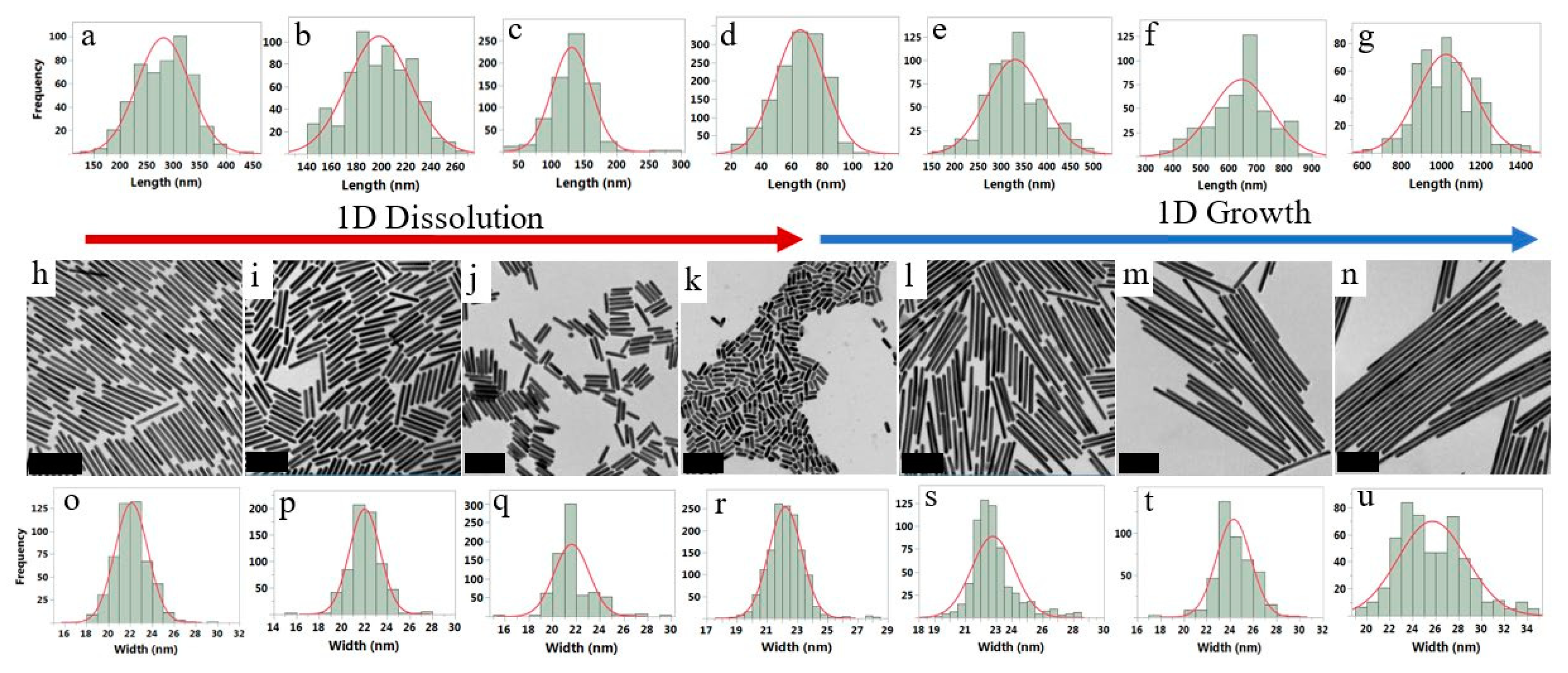

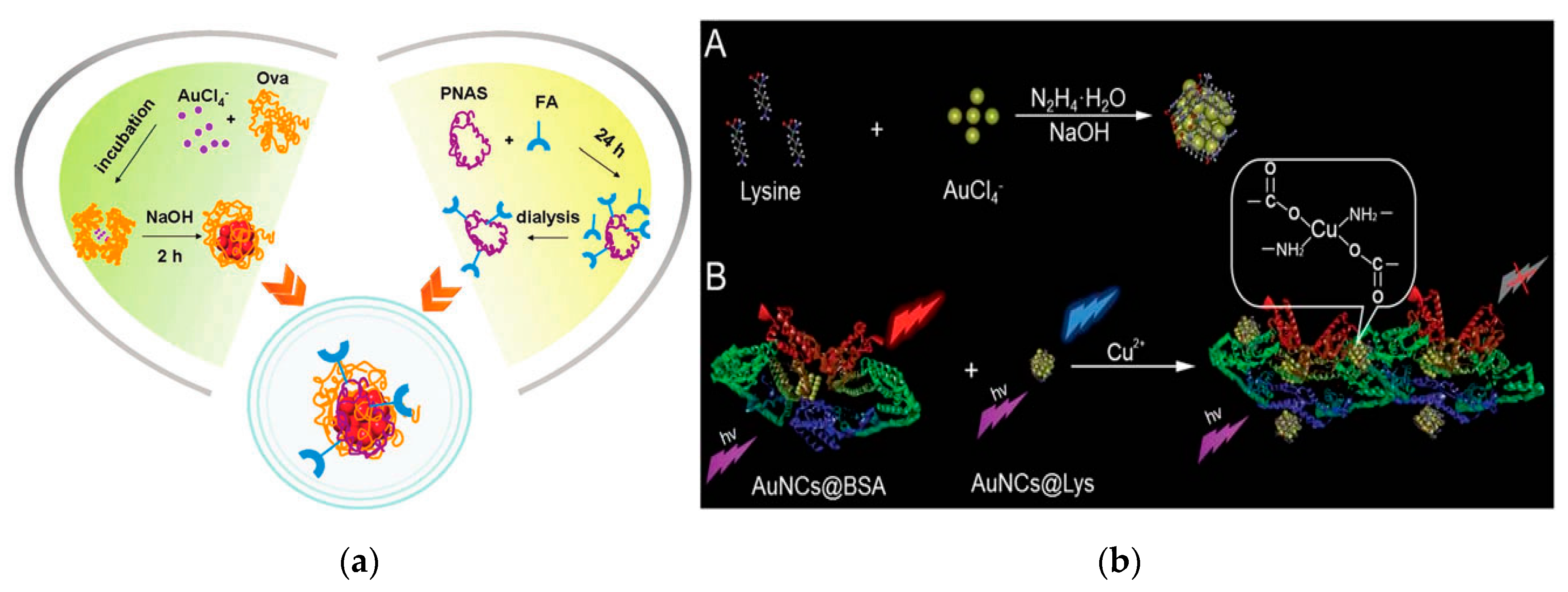
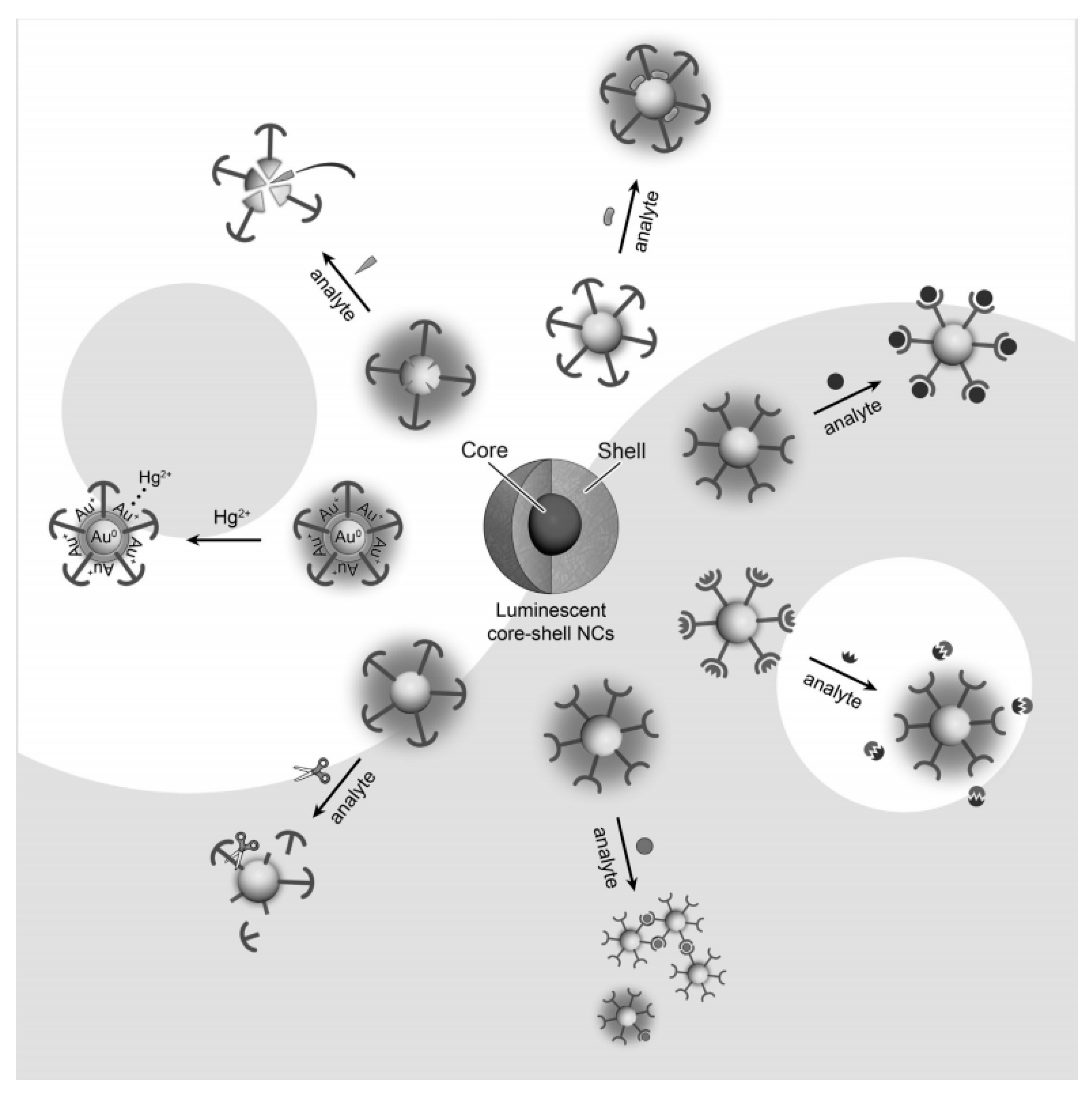
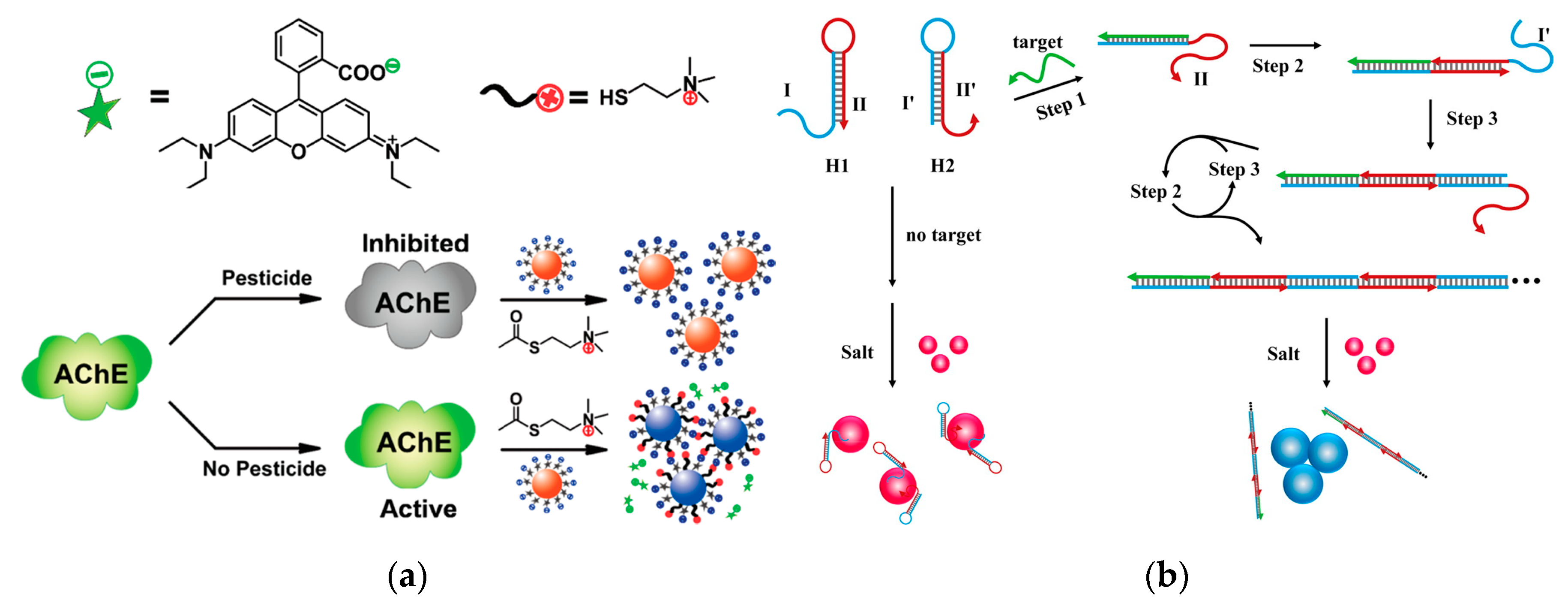
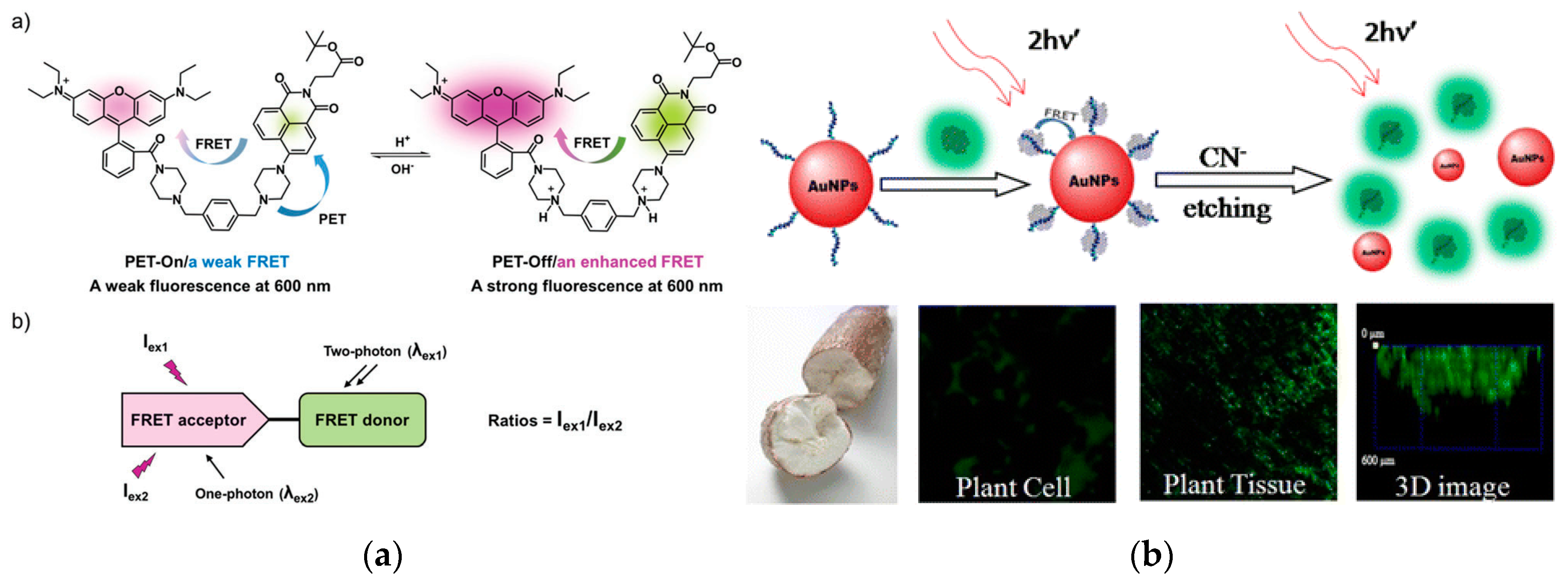
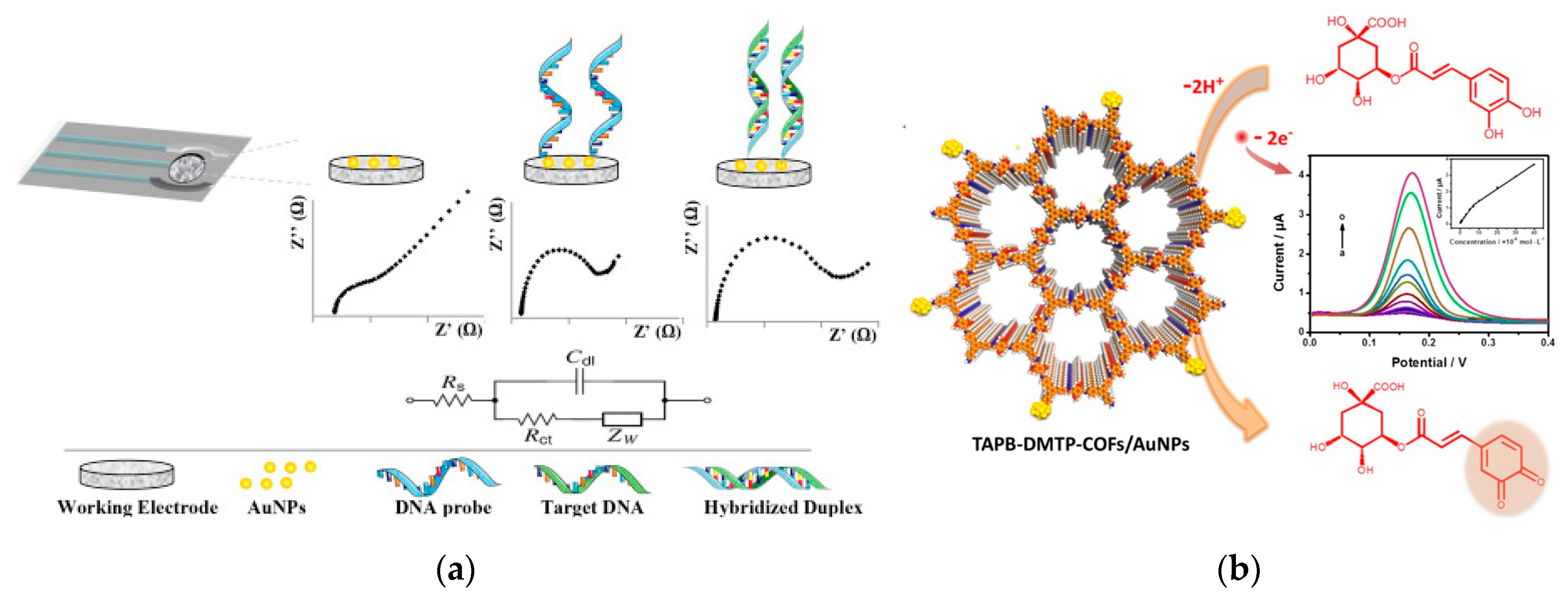
© 2020 by the authors. Licensee MDPI, Basel, Switzerland. This article is an open access article distributed under the terms and conditions of the Creative Commons Attribution (CC BY) license (http://creativecommons.org/licenses/by/4.0/).
Share and Cite
Pan, M.; Yang, J.; Liu, K.; Yin, Z.; Ma, T.; Liu, S.; Xu, L.; Wang, S. Noble Metal Nanostructured Materials for Chemical and Biosensing Systems. Nanomaterials 2020, 10, 209. https://doi.org/10.3390/nano10020209
Pan M, Yang J, Liu K, Yin Z, Ma T, Liu S, Xu L, Wang S. Noble Metal Nanostructured Materials for Chemical and Biosensing Systems. Nanomaterials. 2020; 10(2):209. https://doi.org/10.3390/nano10020209
Chicago/Turabian StylePan, Mingfei, Jingying Yang, Kaixin Liu, Zongjia Yin, Tianyu Ma, Shengmiao Liu, Longhua Xu, and Shuo Wang. 2020. "Noble Metal Nanostructured Materials for Chemical and Biosensing Systems" Nanomaterials 10, no. 2: 209. https://doi.org/10.3390/nano10020209
APA StylePan, M., Yang, J., Liu, K., Yin, Z., Ma, T., Liu, S., Xu, L., & Wang, S. (2020). Noble Metal Nanostructured Materials for Chemical and Biosensing Systems. Nanomaterials, 10(2), 209. https://doi.org/10.3390/nano10020209






